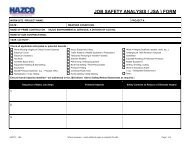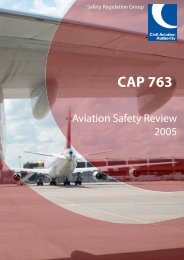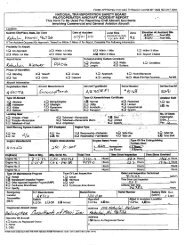International Helicopter Safety Team Safety Management System Toolkit
IHST - Safety Management Toolkit - Skybrary
IHST - Safety Management Toolkit - Skybrary
- No tags were found...
Create successful ePaper yourself
Turn your PDF publications into a flip-book with our unique Google optimized e-Paper software.
12. INFORMATION: Our organization provides<br />
feedback to all employees when an error is made<br />
and ways to avoid repeating the error. It keeps us<br />
informed of areas we can improve on as well as<br />
our successes.<br />
0 5 10<br />
13. MONEY VS. SAFETY: I believe our organization<br />
recognizes that commercial goals and safety<br />
issues can come into conflict and have placed measures<br />
to recognize and resolve such conflicts in an<br />
effective and transparent manner.<br />
0 5 10<br />
14. REPORTING ENCOURAGED: I believe policies<br />
in place to encourage everyone to identify safetyrelated<br />
issues (one of the defining characteristics of a<br />
pathological culture is that safety messengers are seen<br />
as troublemakers and whistleblowers dismissed or<br />
discredited).<br />
0 5 10<br />
15. REPORTING TRUST: I and my fellow employees<br />
trust our management and have reported human<br />
errors over the past 12 months.<br />
0 5 10<br />
16. ADMINISTRATIVE POLICY: Our organization<br />
has an administrative policy that makes clear the<br />
organization’s stance regarding qualified indemnity<br />
against sanctions, confidentiality and the organizational<br />
separation of the data-collecting department<br />
from those involved in disciplinary proceedings.<br />
0 5 10<br />
17. BLAME: I believe my organization disciplinary<br />
policy is based on an agreed (i.e. negotiated) distinction<br />
between acceptable and unacceptable behavior. It<br />
is recognized by all staff that a small proportion of<br />
unsafe acts are indeed reckless and warrant sanctions<br />
but that the large majority of such acts will not attract<br />
punishment. The key determinant of blameworthiness is<br />
not so much the act itself, error or violation, as the<br />
nature of the behavior in which it was embedded. Did<br />
the error involve deliberate unwarranted risk-taking or<br />
a course of action likely to produce an avoidable<br />
error? If so, then the act would be culpable regardless<br />
of whether it was an error or a violation.<br />
0 5 10<br />
18. NON-TECHNICAL SKILLS: I believe our line<br />
management encourages their staff to acquire the<br />
mental (or non-technical) as well as the technical<br />
skills necessary to achieve safe and effective<br />
performance. Mental skills include anticipating<br />
possible errors and rehearsing the appropriate<br />
recoverable recoveries. Such mental preparation at<br />
both individual and organizational levels is one of<br />
the hallmarks of high-reliability systems and goes<br />
beyond routine simulator checks.<br />
0 5 10<br />
19. FEEDBACK: Our organization has in place<br />
rapid useful and intelligible feedback channels to<br />
communicate the lessons learned from both the reactive<br />
and proactive safety information systems.<br />
Throughout, the emphasis is upon generalizing these<br />
lessons to the system at large.<br />
0 5 10<br />
20. ACKNOWLEDGES ERROR: I believe that our<br />
organization has the will and the resources to acknowledge<br />
its errors, to apologize for them and to reassure<br />
the victims (or their relatives) that the lessons learned<br />
from such accidents will help prevent their recurrence.<br />
This is part of the Emergency Response Plan<br />
0 5 10<br />
Add up your score: _____________<br />
160 to 200 – Should be a great organization to work for.<br />
Keep up the vigilance and don’t become complacent.<br />
110 to 155 – A good score. There is always room for<br />
improvement.<br />
60 to 105 – It’s time for management to involve everyone<br />
in forming an action plan.<br />
15 to 55 – Not a good position to be in. The company needs<br />
to work seriously on a <strong>Safety</strong> <strong>Management</strong> <strong>System</strong>. To do<br />
nothing is inviting disaster.<br />
Less then 15 – First day on the job? If not; find a job with<br />
another organization. The odds of a fatal accident are<br />
just too great.<br />
Perhaps some of the policies, practices and procedures<br />
are in place, but you just don’t know about<br />
them. Take to time to find out about any that you<br />
scored a zero on. We all are part of the solution.<br />
Text courtesy of Gordon Dupont, CEO, <strong>System</strong> <strong>Safety</strong> Services<br />
SMS <strong>Toolkit</strong> 49







